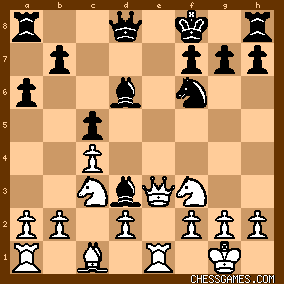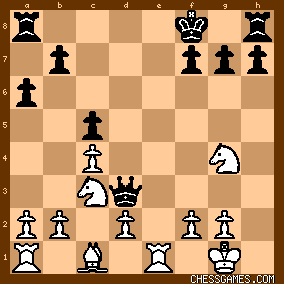Dec-14-13
 | | offramp: A tunguska in a bottle. |
|
| Dec-14-13 | | M.Hassan: "Very difficult"
White to play 21.?
Materials are equal
21.e6 threatening mate on f7
<if...Rxf6 Rxf6 and Black looses a Rook> 21...........Nf6
Note: The above move is my own, the followings is the help received from Chessmaster:
22.Bh6! Qd8
23.Qxc5+ Qe7
24.Bxg7+ Kxg7
25.Qg5+ Kf8
26.Qh6+ Kg8
27.Re5 Ne4
28.Nxe4 Bxe4
29.Rxe4 Qxe6
30.Qg5+ Kf8
31.Rxe6 Rxe6
White stays strong and should win. |
|
Dec-14-13
 | | al wazir: I went with 21. e6+ Nf6 22. e7+ Rxe7 (22...Kg8 23. Bh6 gxh6 24. Qxf6, to be followed by 25. Re3 and 26. Rg3+) 23. Bd6 Ng8 24. Rxe7 Nxe7 25. Re1 Qd8 26. Qe5. |
|
| Dec-14-13 | | diagonalley: i was too focussed on 22.B-Q6+ to even consider 22.B-R6 ... darn |
|
| Dec-14-13 | | morfishine: <21.e6> forces <21...Nf6> due to the mate threat; a thematic possibility based on "pattern recognition" then became evident; the pattern is actually a checking sequence where a Queen, while adjacent to an enemy Knight, is checking the opponent's King, who is endeavoring to avoid checks while remaining in communication with his Knight. The Queen will win if there are no other defenders of the Knight <22.Bh6> A sharp move that brings to light a sub-theme: "the piece out of play". Here, Black is forced to scramble together a defense while his King rook sits idle I spent much time now trying to visualize the best moves or defensive posture for Black. In fact, I spent an excessive amount of time over this move because I frequently fail to find the best defensive moves. I concluded the overall best move was <22...Qd8> supporting his Knight so as to take the sting out of Bxg7+/Kxg7/Qg5+ But other moves deserve consideration too. For example, 22...Rg8 attempts to gain a tempo due to the potential double-attack against g2. An immediate 22...Bxg2 also looked tempting trying to break open the White King position and allow his Queen to penetrate. All this takes time, and inexplicably, I never saw the in-between move 23.Qxc5+ and after much time, checked the game to see if, at least, I was on the right track *****
PM: Quite enjoyable to see a Sveshnikov game, despite him being on the losing end ***** |
|
Dec-14-13
 | | Penguincw: I got 21.e6, although not sure what the follow up would be. |
|
| Dec-14-13 | | RandomVisitor: After 14.Qe3 there is the possibility of a queen sacrifice:
click for larger view Rybka 4.1 x64:
[-0.04] d=20 14...Ng4 15.Qxd3 Bxh2+ 16.Nxh2 Qxd3 17.Nxg4 
click for larger view Rybka 4.1 x64:
[-0.07] d=21 17...h5 18.Ne5 Qf5 19.d4 f6 20.Nf3 h4 21.Ne2 h3 22.Ng3 Qd7 23.Be3 cxd4 24.Nxd4 hxg2 25.Kxg2 Kf7 26.b3 Rad8 27.Kg1 g6 28.Rad1 Rh4 29.Rd2 Qc8 30.Ne6 Re8 31.Nd4 Rhh8 |
|
| Dec-14-13 | | Amadori: <I got 21.e6, although not sure what the follow up would be.>
me too. Can someone tell me why 21...f6 was not the right defense? |
|
| Dec-14-13 | | RandomVisitor: 21.e6 f6 22.Nxd5 Bxd5 23.Qxd5 Qc6 24.Qd7 Qxd7 25.exd7 Rd8 26.Bd6+ Kf7 27.Re7+ Kg6 etc |
|
| Dec-14-13 | | Cheapo by the Dozen: Taking the analysis to 22 Bh6 wasn't hard, and so I imagine a lot of us would have played that over the board. However, I tapped out there. But here's something funny about the game -- Sveshnikov played a Sicilian in which WHITE had the awkwardly backward d-pawn! |
|
| Dec-14-13 | | vajeer: What's the purpose of 23.Qxc5 |
|
| Dec-14-13 | | M.Hassan: <Amadori:Can someone tell me why 21...f6 was not the right defense?> Black looses a piece:
21........f6
22.Nxd5 Bxd5
23.Qxd5
<RandomVisitor>'s analysis shows further moves. |
|
| Dec-14-13 | | agb2002: The material is even.
Black threatens Qxb2, Nxc3-Bd5, and Nxf4-h5-Rh6.
Whute can create a double threat with 21.e6, menacing 22.Qxf7# and 22.Nxd5, 21... Nf6 22.Bh6 A) 22... gxh6 23.Qxf6 wins a lot of material.
B) 22... Kg8 23.Bxg7 Kxg7 (23... Rxe6 24.Bxf6 + -; 23... fxe6 24.Qxf6 + -) 24.Qg5+ Kf8 25.Qxf6 is similar to A.1. C) 22... Rxe6 23.Rxe6 fxe6 (23... gxh6 24.Qxf6 + -) 24.Qxf6+ wins. D) 22... fxe6 23.Qxf6+ Kg8 24.Qxg7#.
E) 22... Qd8 23.Bxg7+ (23.e7+ Rxe7 24.Qxf6 Rxe1+ 25.Rxe1 Qxf6 - +) 23... Kxg7 24.Qg5+ Kf8 25.Qh6+ E.1) 25... Ke7 26.Qg7
E.1.a) 26... Kd6 27.Rad1+ Bd5 (27... Nd5 28.Qe5+ Ke7 29.Nxd5+ + -) 28.e7 Rxe7 29.Qxf6+ wins. E.1.b) 26... Ref8 27.exf7+ Kd6 28.Rad1+ Bd5 (28... Nd5 29.Qe5+ Kd7 30.Nxd5 + -) 29.Nxd5 Nxd5 30.Rxd5+ Kxd5 31.Rd1+ Ke6 32.Rxd8 Rxd8 33.f4 and White should win the endgame. E.2) 25... Kg8 26.Rg5 Ne4 (26... fxe6 27.Rg5+ Kf7 28.Qg7#) 27.Nxe4 wins. |
|
| Dec-14-13 | | James D Flynn: 21.e6 Nf6 22.e7+ Kg8(if Rxe7 23.Bd6 wins the R if Nd5 24.Nxd5 , if Ng8 24.Qc8+ Be8 25.Bxe7+ Nxg7 26.Rxe7 Kxe7 27.Nd5+ forks K and Q) 23.Bh6( threat Bxg7+ and Qg5#) gxh6 24.Qxf6 h5 25.Re3 Rxe7 (to avert mates on the g file) 25.Rxe7 and the f7 mate can only be averted by Be8 which loses to Qxb6. |
|
| Dec-14-13 | | Patriot: 21.Ne4 Ne7 seems to defend
21.Nxd5 Bxd5 22.e6 Bxe6 defends well too I think.
21.e6 Nf6 22.e7+ Kg8 23.Bh6 looks pretty strong.
21.e6 Nf6 22.e7+ Rxe7 23.Bd6 
That's all I have time for tonight. |
|





